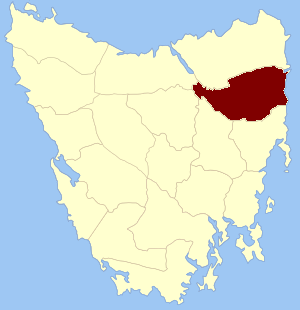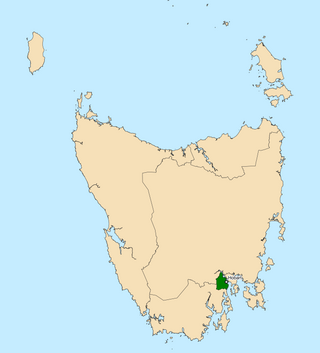
The House of Assembly, or Lower House, is one of the two chambers of the Parliament of Tasmania in Australia. The other is the Legislative Council or Upper House. It sits in Parliament House in the state capital, Hobart.

The Parliament of Tasmania is the bicameral legislature of the Australian state of Tasmania. It follows a Westminster-derived parliamentary system and consists of the governor of Tasmania, the Tasmanian House of Assembly, and Tasmanian Legislative Council. Since 1841, both Houses have met in Parliament House, Hobart. The Parliament of Tasmania first met in 1856.
The Division of Bass is an Australian electoral division in Tasmania.
The Division of Braddon is an Australian electoral division in the state of Tasmania. The current MP is Gavin Pearce of the Liberal Party, who was elected at the 2019 federal election.

The electoral division of Windermere is one of the 15 electorates or 'seats' in the Tasmanian Legislative Council. The division is located on the East side of the Tamar River. It is named after the town of Windermere which is located along the banks of the river between Launceston and George Town.

The electoral division of Rosevears is one of the 15 electorates or 'seats' in the Tasmanian upper house. The division is located on the west side of the Tamar River. It is named after the town of Rosevears which is located on the river banks near Exeter.

The electoral division of Franklin is one of the five electorates in the Tasmanian House of Assembly, located in southern Tasmania and includes Bruny Island, Kingston and the eastern shore of the Derwent River. Franklin is named after Sir John Franklin, the Arctic explorer who was Lieutenant-Governor of Van Diemen's Land (1837–43). The division shares its name and boundaries with the federal division of Franklin.

The electoral division of Braddon is one of the five electorates in the Tasmanian House of Assembly, it includes north-west and western Tasmania as well as King Island. Braddon takes its name from the former Premier of Tasmania, Sir Edward Braddon. The division shares its name and boundaries with the federal division of Braddon.

The electoral division of Lyons is one of the five electorates in the Tasmanian House of Assembly, with the largest electorate and covering most of central and eastern Tasmania. Lyons is named jointly in honour of Joseph Lyons, Prime Minister of Australia (1932–1939); Premier of Tasmania (1923–1928), and Joseph's wife, Dame Enid Lyons, the first woman elected to the Australian House of Representatives in 1943. The electorate shares its name and boundaries with the federal division of Lyons.

The electoral division of Pembroke is one of the 15 electorates or 'seats' in the Tasmanian Legislative Council or upper house. It is located on Hobart's Eastern Shore and includes a number of suburbs; Risdon Vale, Geilston Bay, Rose Bay, Lindisfarne, Warrane, Mornington, Bellerive, Howrah and Tranmere. In earlier times, the division included most of the east coast of Tasmania as far north as Bicheno, including the Tasman Peninsula.

The electoral division of Rumney is one of the 15 electoral divisions in the Tasmanian Legislative Council. The division is located in Southern Tasmania to the east of the division of Pembroke.

The electoral division of Derwent is one of the 15 electoral divisions in the Tasmanian Legislative Council. It is situated in the central south of the state.

The electoral division of Nelson is a constituency of the Tasmanian Legislative Council. The division includes many of the suburbs to the south of Hobart, including South Hobart, Sandy Bay, Taroona and Kingston. The division was created in 1999 when the electoral division of Queenborough was renamed in a review of electoral boundaries. The member from 1999 until his retirement in 2019 was independent Jim Wilkinson.

Cornwall Land District is one of the twenty land districts of Tasmania which are part of the Cadastral divisions of Tasmania. It contains most of Launceston. It was formerly Cornwall County, one of the 18 counties of Tasmania and one of the first eleven proclaimed in 1836. It was named after the then southwestern county of England.
Brian Neal Wightman is an Australian politician who served as Attorney-General of Tasmania from 2010 to 2014.

The electoral division of Hobart is one of the 15 electoral divisions in the Tasmanian Legislative Council. It was originally created in 1856 when the Council became the upper house of the Parliament of Tasmania. The seat was abolished in 1999 and re-created in 2008 after a redistribution saw the former division of Wellington returned to its former name.

The electoral division of McIntyre is one of the fifteen electorates in the Tasmanian Legislative Council, it includes Flinders Island, the northern east coast of Tasmania, and regional areas south and west of Launceston. It is named after Margaret McIntyre, who was the first woman to be elected into the Parliament of Tasmania in 1948.

The electoral division of Prosser is one of the fifteen electorates in the Tasmanian Legislative Council, it includes the south-east coast of Tasmania, the Sorell township and the Tasman Peninsula. Prosser is named after the Prosser River, which flows through the centre of the division.
The Division of Clark is an Australian Electoral Division in the state of Tasmania, first contested at the 2019 federal election.

The electoral division of Clark is one of the five electorates in the Tasmanian House of Assembly, it is located in Hobart on the western shore of the River Derwent and includes the suburbs below Mount Wellington. Clark is named after Andrew Inglis Clark, a Tasmanian jurist who was the principal author of the Australian Constitution. The electorate shares its name and boundaries with the federal division of Clark.















